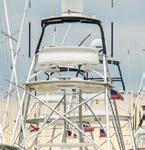




















































































The June 2025 magazine you are holding in your hand (or reading online) is our second food issue.
While our first foray into Mississippi’s cuisine last year was a deep dive into fried chicken, this year we went a little further. Fried chicken is just one of the many hot goodies to be found at a gas station.
Forget our friends up north. Down south, we love gas station food. I’m guessing most of us won’t make any apologies for that.
For years, gasoline hasn’t been the only fuel we need when we stop at a service station.
We reached out to our local electric cooperatives around the state and asked them to tell us about their favorite gas station food and where to find it in or near their territories.
We feature a few of those choices in our cover story and provide a list of the others they told us about to give you a handy statewide guide.
An issue like this is nice to have in your vehicle’s glove compartment for those times you find yourself somewhere in Mississippi other than your home base.
From ribeye angus steak and salads to peanut butter pie, these gas stations serve just about anything you might be craving.
Mississippi is many things.
Food is one of those many things the state is known for, so a magazine piece devoted to gas station cuisine made a lot of sense to us.
Hope you find your favorite gas station food after delving into the June issue.
Enjoy and bon appetit!

by Michael Callahan
Executive Vice President/CEO Electric Cooperatives of Mississippi





Pink streaks of clouds that color the evening sky.
Flocks of wood ducks flying by, Silhouettes of cypress and pine trees, as the sun dips below.
Their limbs stretching out in the final glow
Twilight arrives, dimming the view.
Except for the twinkling of Venus rising on cue.
The crickets sing a lullaby, bidding us goodnight.
Winding down this happy hour with all its glorious sights. by Holly Huye, a resident of Picayune, and a member of Coast Electric
What’s Mississippi to you? What do you treasure most about life in our state? Send your brief thoughts to Today in Mississippi, news@ecm.coop or mail to P.O. Box 3300, Ridgeland, MS 39158.
Submit your beautiful digital photo of life in Mississippi to Today in Mississippi, news@ecm.coop





The Official Publication of the Electric Cooperatives of Mississippi
Vol. 78 No. 06
OFFICERS
Brian Hughey - President
Brian Long - First Vice President
Shawn Edmondson - Second Vice President
Brian Clark - Secretary/Treasurer
Michael Callahan - Executive Vice President/CEO
EDITORIAL STAFF
Lydia Walters - VP, Communications
Steven Ward - Editor
Chad Calcote - Creative Director
Kevin Wood - Graphic Designer
Alan Burnitt - Graphic Designer
Jill Sowell - Graphic Designer
Whitley Daughtry - Graphic Designer
Chris Alexander - Member Services Coordinator
Andy Tuccio - Media Solutions Director
Steve Temple - Social Media Director
EDITORIAL OFFICE & ADVERTISING
601-605-8600
Acceptance of advertising by Today in Mississippi does not imply endorsement of the advertised product or services by the publisher or Mississippi’s electric power associations. Product satisfaction and delivery responsibility lie solely with the advertiser.
• National advertising representative: American MainStreet Publications, 800-626-1181
Circulation of this issue: 473,487
Non-member subscription price: $9.50 per year.
Today in Mississippi (ISSN 1052-2433) is published 12 times a year by Electric Cooperatives of Mississippi Inc., P.O. Box 3300, Ridgeland, MS 39158-3300, or 665 Highland Colony Parkway, Ridgeland, MS 39157. Phone 601-605-8600. Periodical postage paid at Ridgeland, MS, and additional o ce. The publisher (and/or its agent) reserves the right to refuse or edit all advertising. The magazine is published for members of subscribing co-ops. The magazine is a bene t of membership.
POSTMASTER: Send all UAA to CFS. (See DMM 507.1.5.2) NON-POSTAL AND MILITARY FACILITIES: send address corrections to: Today in Mississippi, P.O. Box 3300, Ridgeland, MS 39158-3300

www.facebook.com/TodayinMississippi
www.todayinmississippi.com

Electric cooperative leaders from Mississippi went to Washington, D.C., in April for the National Rural Electric Cooperative Association’s (NRECA) Legislative Conference to engage members of Congress and urge policymakers to take action to help meet the growing demand for electricity.
“The Legislative Conference allows co-ops to speak to policymakers with one voice on issues that a ect us and our local communities,” NRECA CEO Jim Matheson said. “And while that is important every year, it is especially important at the start of a new Congress and a new administration.”
Mississippi co-op leaders met with Senators Roger Wicker and Cindy-Hyde-Smith as well as Congressmen Mike Ezell, Bennie G. Thompson, Michael Guest, and Trent Kelly to discuss pending legislation and regulatory reform.
“Even in today’s modern age of advocacy, there is still no more powerful tool than a good relationship and a face-to-face meeting with a policymaker,” said Hill Thomas, NRECA’s vice president of legislative a airs. “These have always been electric cooperative strong suits. Legislative Conference is the time to put that engagement to work.”

Over the next 10 years, winter peak demand is expected to rise about 18%, according to the North American Electric Reliability Corp.’s most recent Longterm Reliability Assessment.
NRECA members from all over the country urged Congress to pass additional reforms to environmental permitting that speeds up the process for co-ops to obtain federal approval to build crucial infrastructure projects. Co-op leaders want the legislation to include litigation reform that places reasonable limits on lawsuits seeking to block projects that have already received permits.

The Electric Cooperatives of Mississippi (ECM) and three local electric cooperatives took home 2025 Spotlight on Excellence Awards this year.
The awards are sponsored by the National Rural Electric Cooperative Association (NRECA) and the Council of Rural Electric Communicators. The awards shine a light on remarkable talent and innovation by recognizing a body of outstanding work produced by electric cooperative communication and marketing professionals from across the country.
ECM’s Legislative Roster App earned the top honor — gold — in the “Most Innovative Use of Digital Engagement” category.
The app allows users to find their statewide elected o cials as well as their state senators and representatives in seconds. Besides profiles and maps for lawmakers and their districts, users can find out which legislators are on the Seante and House committees and follow the progress of proposed bills through each session.
Cooperative Energy, a generation and transmission cooperative, won a gold award in the “Best Wild Card” category for their Cooperative Energy SPARK Award.
Dixie Electric won a first-place gold award in the “Best Short Form Video (Two Minutes or Less)” category for their piece, “Silent Strength: The Unsung Heroes of Power.”
Coast Electric won a silver award in the “Most Innovative Use of Digital Engagement” category for their piece, “Welcome to the Neighborhood.”
In other award news, ECM Vice President of Communications Lydia Walters won the Dave D’Avanzo Communications Leadership Award in May.
The Pioneer Utility Resources award honors co-op communicators known for giving, helping, and lifting others up in their careers in the cooperative world.
The peer-nominated award celebrates quiet leaders in the industry who make work and communities better in meaningful ways.
Congratulations to all the winners!



















One of my favorite plants that thrive in sunny landscapes is yarrow, a tough, drought-tolerant perennial that does especially well in full sun and well-drained soil. Once established, yarrow is very low maintenance and even thrives in poor, sandy or rocky soils.
Yarrow produces clusters of tiny flowers that form broad, flat-topped heads which are perfect landing pads for butterflies, bees, moths, and other pollinators. The native variety has delicate, frilly white flowers on tall, multi-branching stems, but there are also cultivated varieties in pink, yellow, red, and orange.
Another of my favorite native perennials is Stoke’s aster, which adds long-lasting color to sunny beds and borders. It grows low to the ground, forming a tidy mound of dark green, lance-shaped leaves.
If you are looking to include some native plants to the sunny areas of your landscape, consider these selections that providebeauty and texture. You really can’t go wrong using these choices to create a colorful, wildlife-friendly garden.
Their finely divided, feathery foliage gives the plant a soft, lacy appearance in the garden.
Yarrow spreads slowly by rhizomes and can also self-seed, so I like to keep an eye on it. I divide the clumps every few years to manage growth and encourage more blooms.
The large, daisy-like flowers measure 2 to 4 inches across and bloom from late spring to well into summer. The lavender-blue petals are deeply fringed and surround a striking purple center.
Stoke’s aster thrives in full sun but can tolerate a bit of afternoon shade, especially in hot climates like ours here in the South. It prefers moist, well-drained soil but is surprisingly tolerant of short periods of drought once established.
I’ve found Stoke’s aster to be a butterfly magnet, and it is a great choice for adding texture and color to pollinator gardens. It requires little pruning — a light deadheading will encourage continued blooming.








The next sun-loving native plant to consider is Turk’s cap, a shrub that performs beautifully in our Southern climate. It tolerates a range of conditions and can handle full sun to partial shade. The best flower production occurs in spots that get at least 6 hours of sun a day.
Turk’s cap has large, velvety green leaves that are 4 to 6 inches across and remind me of baseball mitts. These leaves give the plant a lush, tropical look, especially when paired with the plant’s striking, scarlet-red blooms.
The flowers have a distinct, twisted shape that never fully opens, giving them the look of a tiny turban, hence the name. These blooms appear from late spring through first frost and are irresistible to hummingbirds, butterflies and bees.
Turk’s cap tolerates heat, humidity, drought and even poor soil. It can grow from 3 to 6 feet tall and wide, depending on conditions.


If you are looking to include some native plants to the sunny areas of your landscape, consider these selections that provide beauty and texture. You really can’t go wrong using these choices to create a colorful, wildlife-friendly garden.

by Dr. Eddie Smith






































More than 100 of the largest recreational fishing boats in the world will gather in Biloxi from June 2-8 to compete in the 28th annual Mississippi Gulf Coast Billfish Classic, one of the largest and richest fishing events on the Gulf Coast.
“Boats can leave the dock at 11 a.m. June 5,” said Bobby Carter, event founder from Ocean Springs. “They must be back to the dock by 6 p.m. June 7 to weigh their fish.”
The weigh-in takes place at Point Cadet Marina behind the Golden Nugget Hotel and Casino. These boats head to deep waters to fish for blue marlin, swordfish, tuna, wahoo, dolphin fish, also called mahi, and other big-game species with millions of dollars at stake.
“This year, we are putting up $150,000 to the first person to break the Mississippi state white marlin record, which is only about 80






pounds,” Carter explains. “We also increased our entry fee from $6,000 to $7,500. We’re going to put that extra $1,500 in the tuna, dolphin and wahoo division. We have people coming from the East Coast, Key West, Corpus Christi, and all points in between.”
Before this tournament began in 1997, few anglers considered the Mississippi Coast as a big-game destination. However, boats running out of Mississippi ports often catch huge fish.
To attract attention to Mississippi from big-game anglers, Carter came up with an idea. Back then, the Mississippi state record blue marlin weighed less than 500 pounds. This species can grow to more than 1,400 pounds. He found a backer to put up $100,000 for the first person entered in a new tournament to break the Mississippi state record.



“My goal was to get at least 20 boats entered in that first tournament,” Carter said. “We had 60 boats entered. They came from all over the place.”

A Georgia boat came to the weigh station first with a huge blue marlin. A 17-year-old fishing with his grandfather caught one weighing 635 pounds. Another boat came in behind them with a much larger fish.
“The second marlin weighed 917 pounds, but it had big gash marks along its side,” Carter said. “When they went to ga the fish, it got caught in the boat prop. The tournament followed International Game Fishing Association rules, which disqualifies mutilated fish. However, Mississippi doesn’t follow such rules.”
The tournament disqualified the 917-pound mutilated fish, so the young man who came with the 635-pounder won the marlin division and $100,000 for breaking the state record. However, he didn’t hold the record for long. Minutes later, the state certified the 917-pounder, breaking the 635-pound record, as the new Mississippi state record.
The weigh-in is free to the public. Spectators can listen to live music at the dock on June 3 and 4. An estimated 5,000 to 10,000 spectators will come to see big fish weighed.
“It’s a good family atmosphere with a major economic impact on the Mississippi Coast,” Carter said.
For information on the Mississippi Gulf Coast Billfish Classic visit MGCBC.com.






by John N. Felsher
John N. Felsher is a professional freelance writer, broadcaster, photographer, and editor who lives in Alabama. An avid sportsman, he’s written more than 3,300 articles for more than 170 different magazines on a wide variety of outdoors topics.Contact him at j.felsher@hotmail.com.






by Steven Ward
When customers stopped going out to restaurants during the pandemic, Mississippi’s hospitality and tourism industry was almost destroyed.
State Sen. Lydia Chassaniol (R-Winona), chairwoman of the Senate’s Tourism Committee and a former restaurant owner, made it her mission to come up with ideas that would help rejuvenate the industry.
“That’s when I first had the idea of a TV show that would celebrate food and storytelling. Lots of people visit Mississippi because of the blues or certain museums. Well, if there’s one thing I know it’s this: 100% of all tourists in the state need to eat,” Chassaniol told Today in Mississippi recently.
Food is something the state is famous for and Chassaniol wanted to use that as a catalyst to tell the culinary history of Mississippi.
“This has all been Sen. Chassaniol’s brainchild,” said Mississippi
Public Broadcasting (MPB) Chief Content O cer Taiwo Gaynor. That idea has become “Southern Dish,” a new television show that celebrates the state’s rich culinary heritage and the talented chefs who bring it to life.
According to MPB, the show “will take viewers on a journey through the state’s most iconic kitchens. The show will explore not only the food, but also the personal stories of the chefs, their families, and the deep-rooted traditions that make Mississippi’s culinary scene one of the best in the nation.”
Chassaniol not only came up with the idea for the program, but she is also the show’s host.
“When they first asked me if I would be comfortable behind the camera, I told them it wasn’t a problem. I used to be a teacher, and I’ve been in politics for almost 20 years. I can talk,” Chassaniol said laughing.



Chassaniol and MPB shot a pilot episode and premiered it in the Old Supreme Court Chamber at the State Capitol in March. During the episode, Chassaniol visited with John Ballas, the owner of the Crystal Grill in Greenwood, famous for their “Mile-High Pies,” which the pair made during the show. Although Ballas closed the historic restaurant last summer, Chassaniol and Ballas talked about the restaurant’s fascinating history.
During the other portion of the pilot, Chassaniol visited with Chaz Lindsay, owner and executive chef of Pulito Osteria, an Italian restaurant in Jackson’s Belhaven neighborhood.
Gaynor said MPB plans to shoot episodes for the first season during the summer with a plan to begin airing the program in July 2026.
“At MPB, it’s our job to tell Mississippi stories. And we feel like food is one of the best ways to do just that,” said Royal Aills, MPB’s executive director.
Both Gaynor and Aills said Chassaniol is the perfect host for the show.
Food has played an important role in Chassaniol’s life, she said.
A former art teacher, Chassaniol was born and raised in Winona.
The daughter of a livestock auction business owner, Chassaniol learned how to cook from her mom, who ran a part-time café during her father’s auctions.







Food is a big part of the story of Mississippi. And I see the show as a love letter from Mississippi to rest of the country.


“My mother was a wonderful cook, but my cooking is not like hers. She used a lot of vegetables, whereas I’m more of a carnivore when it comes to my stu ,” Chassaniol said.
Later in life, the senator ran a catering business out of her home kitchen, until state law outlawed that method. Before she was elected to the Legislature in 2007, Chassaniol owned and ran a Winona restaurant, The Sample Room. She had to close the restaurant after she became a senator.
Food was also the way she and another freshman senator at the time — Joey Fillingane (R-Sumrall) — got to know other longtime legislators after they were elected.
“I said, Joey, we need to figure out a way to get these folks to like us,” Chassaniol said. So, the pair hosted a senate dinner every session that still occurs today.
“I make beef tenderloin, pork tenderloin, pork sausage — and it has to be Polk sausage of course (Polk’s Meat Products is State Sen. John A. Polk’s family business) — Pasta Alfredo, and marinated shrimp and artichokes. Joey makes a terrific Punchbowl Cake and baked tomatoes,” she said.
“There are no enemies when it comes to food.”
Chassaniol said maybe the show might make her “a redneck Martha Stewart.”
But “Southern Dish” is really about the food of Mississippi and the stories behind it.
“Food is a big part of the story of Mississippi. And I see the show as a love letter from Mississippi to rest of the country.”
— Gene H.

Switzerland is synonymous with expensive, big-name luxury watches like Rolex®, Piaget® and Patek Philippe® that sell for thousands, but the Stauer Swiss Tactical Watch delivers Swiss precision for a fraction of the cost. Inspired by military timepieces like the American A-11, it combines rugged performance, simplicity, and legendary craftsmanship — built for action, not display cases.
Precision Takes Time
Swiss excellence demands patience. Each Stauer Swiss Tactical takes nearly nine months to complete, and this is a limited edition of 4,900. Crafted by master watchmakers, some of whom have worked with the other prestigious brands, this is your chance to own a rare, precision-engineered tactical watch without the inflated luxury price tag.
Why Pay for a Name?
Big brands charge more for status. Stauer delivers the same quality and precision with high-contrast markers for instant readability, a shock-resistant case to withstand hard knocks and Swiss-made movement for impeccable timing.
Limited Offer – Act Now
Don’t miss this rare combination of Swiss craftsmanship and unbeatable value. Only 4,900 available — once they’re gone, they’re gone.
Why pay more when you can own precision, heritage, and adventure for less? Order now — time is running out.
Watch Specifications:
• Made in Switzerland with precision Swiss Ronda 515 movement. Stainless steel caseback. Brown leather band
• 44 mm diameter case. Date window at 3 o’clock
• Water-resistant to 3 ATM. Fits wrists up to 8 ¼”
Stauer Swiss Tactical Watch
$399 $59* + S & P Save $340
*Special price only for customers using the offer code.
Your Insider Offer Code: SST212-01





























































































• Rate schedule is based on your current age and is guaranteed for the life of the policy.
• Monthly rates as low as $3.49.
• Coverage is also available for your spouse and other family members.
• Benefits will NEVER be canceled or reduced for the life of the policy if premiums are paid on time.
• Rates are based on your children’s or grandchildren’s present age and never increase for any reason.
• Monthly rates as low as $2.17.
• Benefits will NEVER be reduced or canceled if premiums are paid on time.
• Give your children a financial head start right now. Your policy builds CASH VALUE for your family’s needs.





















SERVING MORE THAN 12,600 ELECTRIC METERS IN SEVEN DELTA COUNTIES




Hollandale - 662-827-2262 | Belzoni - 662-247-1909 | Greenville - 662-334-9543 | Rolling Fork - 662-873-4233 | REPORT OUTAGES 866-897-7250 @twincoepa twincoepa.com
Twin County EPA celebrated linemen with a red-carpet arrival to kick o national Lineman Appreciation Day on April 18.
The sta joined them for lunch followed by an action-packed video, and a wonderful message from General Manager Leslie Holloway, reminding everyone that linemen’s unwavering dedication and commitment are the backbone of our organization.
“We deeply value your hard work and the exceptional service you provide to our members. Your contributions make a significant di erence, and we are grateful for everything you do,” Holloway said.
Holloway concluded the event by leading everyone in the “Lineman Prayer.”
Photos were taken at each Twin County branch. Twin County was honored to have Central District Public Service Commissioner DeKeither Stamps attend the event.















Twin County EPA is proud to partner with and support the Mississippi Delta Community College /CAPPS Center’s Lineman Program. Twin County sta coached and judged the school’s Lineman Rodeo.
Congratulations to MDCC Lineman Class No. 30.






years of Dolly Parton’s
Twin County EPA is proud to participate locally in Dolly Parton’s book gifting program that mails free, high-quality books to children from birth to five years of age.




Our inaugural campaign kicked-o last year with “Dunking Booth for Dolly.”















QWhat are some energy e ciency upgrades I should consider when building a new house?



APrioritizing energy e ciency when building a new home can create future savings and make living more comfortable. It might cost a little more upfront but will pay o in the long run.


by Miranda Boutelle

Let’s explore two approaches: Following an energy e ciency certification plan or adding energy e cient designs and equipment to your construction project.
There are several e ciency certifications available for new-construction homes that may qualify for discounted homeowner’s insurance, tax credits, and other incentives.
Leadership in Energy and Environmental Design (LEED) certification ensures the home uses less energy while prioritizing sustainable resources and healthy indoor air quality. LEED-certified homes use 20% to 30% less energy than the average home — with some homes saving up to 60% — and can cost the same as non-LEED homes with proper planning, according to the U.S. Green Building Council.


Passive House certification requires the home to be so e cient it needs little to no heating and cooling equipment while remaining comfortable for its occupants. To achieve up to 90% less energy use than the average home, the certification focuses on maximizing the e ciency of the building envelope — all components that separate the indoors from the outdoors — including proper insulation levels, air sealing and high-e ciency windows.
ENERGY STAR® NextGen Certification for New Homes recognizes houses that are 20% more e cient than the average home and help reduce greenhouse gas emissions by 40% to 80%.
Although various certifications are available, you don’t have to follow a set guide. Consider adding these energy e ciency principles to your new home build.





Advanced framing techniques maximize the amount of insulated area and save on material costs in woodframed homes. This technique can save up to $500 for a 1,200-square-foot home and $1,000 for a 2,400square-foot home on material costs, between 3% to 5% on labor costs and up to 5% on annual heating and cooling costs, according to the U.S. Department of Energy. Choose a contractor who is familiar with these techniques, and check with your local building o cials to ensure compliance with local codes.
The importance of a home’s orientation is often overlooked. According to the International Association of Certified Home Inspectors, homes oriented to the path of the sun use less energy for heating and cooling to reduce energy bills and improve comfort.
Advanced framing techniques maximize the amount of insulated area and save on material costs in wood-framed homes. This technique can save up to $500 for a 1,200-square-foot home and $1,000 for a 2,400-square-foot home on material costs.
If you are building or buying a new home that doesn’t allow options for orientation or framing, you might be able to request higher insulation levels in the attic. Increasing the insulation levels likely won’t cost much more for materials and labor, but it can help you use less energy and save money in the long run.
Heating and cooling equipment should be properly sized using energy modeling tools that calculate the home’s heating and cooling needs. Investing in a more e cient building envelope that is well insulated and air sealed can reduce the home’s heating and cooling load, making it possible to have a smaller, less expensive heating and cooling system. This saves money on equipment costs and lowers energy use.
Optimizing the e ciency of a new home requires a whole-house approach. Analyze all systems and how they work together to ensure maximum e ciency for a safe and comfortable home.
Miranda Boutelle is the chief operating o cer at E ciency Services Group in Oregon, a cooperatively owned energy e ciency company.






















by Michael Leitman
Providing members with safe, reliable, and a ordable power is the mantra for electric cooperatives across the nation. Co-op members can see the work necessary to maintain reliable electricity at the local level, such as co-op lineworkers maintaining utility poles and wires and repairing them after major storms. At the regional and national levels, a diverse mix of power generation resources, transmission lines, and pipeline infrastructure are essential cornerstones of maintaining reliable electricity.
The U.S. electric grid has undergone major changes over the last decade. The share of electricity generated from coal plants has declined significantly, while the share from natural gas and intermittent wind and solar generation has grown. Fuel diversity means that your electricity is supplied by a variety of generation technologies, each with their own characteristics and performance capabilities over di erent weather and seasonal conditions.
Dispatchable technologies can be turned on and o as needed. Large steam generation plants (most commonly using coal or nuclear fuels) are generally considered “baseload,” meaning that they are designed to run e ciently 24/7 to serve as the base of the electricity mix. However, steam plants are less capable of ramping output up or down to meet the various peaks and dips as grid conditions change.
Natural gas is the most versatile fuel, powering large combinedcycle plants that can operate as baseload but are also more flexible ramping up and down. These capabilities are essential for meeting demand on the hottest and coldest days, and for balancing intermittent renewable energy sources, such as solar and wind.
Most hydroelectric power comes from generators inside large dams, which can be dispatched when needed — as long as there is enough water available. Cooperative Energy, a Mississippi generation and transmission cooperative, has several contracts to buy hydroelectric power from the Southeastern Power Administration.
Over the last decade, the share of electricity generated from wind and solar plants has increased dramatically. These beneficial, “no-fuel-required” plants can deliver low-cost electricity — but they only generate electricity when the wind blows and the sun shines. The production patterns of solar and wind technologies are complimentary to one another. Solar generates during the day and wind tends to generate more at night. Across seasons, wind output is typically higher during the colder months when there is less sunshine. Deployed together, wind and solar technologies can balance each other. Although there is a limited availability of wind power in Mississippi, there is a small amount that supplements power in the state from The Midcontinent Independent System Operation (MISO), a regional power reliability group that counts the state as a member.
















While battery energy storage technology is growing rapidly to allow some control of when renewable energy sources can be dispatched, natural gas plants remain the primary method for “firming” renewable generation resources.
Ultimately, our electric grid is most reliable when a wide range of technologies is available. When conditions lead to lower generation from one type of source, others can help compensate. When there is an imbalance, such as a major winter storm when electricity use skyrockets, grid operators are forced to rely on purposefully reducing demand and occasionally plan rolling blackouts to keep the grid operating.
While there is variation across regions in what types of power plants can be built based on weather and infrastructure, America’s electric cooperatives work diligently to ensure a diverse and reliable power supply for the communities they serve.

Our electric grid is most reliable when a wide range of technologies, including traditional and renewable energy sources, is available.
If you're tired of having knee pain and want to talk to a doctor that can virtually give you your life back if knee pain is an issue, call Dr. Rob Acord... as he's the only doctor in the area... who has this newly discovered knee pain reduction technology.
If you have knee pain, can't walk because of an old injury, or you just think it's part of getting old, you might want to read this article.
Knee pain is something that disables a lot of people every single year, but most people don't know what to do about it.
Some people immediately opt in for surgery, then some people watch TV and end up buying something they wrap their knee with-hoping it will help, and others just follow orders and take medications which simply block the pain signals while the underlying condition often progresses.
All I'm saying is this. There are a lot of ways to TREAT your knee pain, but which one will really work?
If you've done your research, you know that there are not a lot of things that really work when it comes to actually helping align the knee, taking nerve pressure off the knee, and reducing the pain and swelling.
What if there was a "real solution" that worked from DAY ONE?
Hi, I'm Dr. Rob Acord and I'm here to tell you about a new device called the K.P.R.
I stumbled onto this one-of-a-kind machine at a recent medical conference and tried it myself. THE RESULTS: My knees have never felt so good, and that was after.... just one treatment.
It virtually reduced my knee stiffness by 95%, so I am positive it'll help your knee pain, help you walk better as soon as you get your first treatment, plus help you do some things you used to do without the help of a walker, cane, or someone else helping you

Now, don't get me wrong. I'm not guaranteeing a miracle if you haven't walked in many years.... but this just may be the answer you've been looking for.
Better late than never for sure. You should entertain this option... no matter what's happened to you in the past!
Let me be very clear; I'm here to possibly help you:
Get out of pain
Walk better
Move better
Get up and down better
Get out of chairs easier
AND...
Finally you will be able to move without relying on someone or something else
"What if my knee(s) are BONE ON BONE?"
Here's all I can tell you If you’re bone on bone, and surgery is not an option for you, or surgery didn’t work, this may be the exact treatment you’ve been needing
You'll find out that K P R is an amazing machine when teamed up with our Class IV laser therapy
Great questions and here's the answer: We have a reputation for getting great results, but if you're like most of our patients you know that the knee problem isn't going to just go away on its own. We're also known for our personalized care We don't promise the world, but we will do everything humanly possible to get the results you want.
"I've NEVER done this before!" I'm going to offer you a consultation, knee examination, X-Rays, and TRIAL VISIT for only
$47 $47
We'll know almost IMMEDIATELY if we can help and most importantly, YOU WILL TOO
As you know, it's human nature to procrastinate; this is not the time to do that... WHY?
My Trial Offer goes away at the end of this month It's available as a hard deadline because I have a limited number of trial spots and we are already an extremely busy office. Pick up the phone and call the office now This one call could change the way you walk, feel, and move CALL TODAY! Dr. Rob Acord, D.C.







by Steven Ward
Gas station sushi? Who would eat gas station sushi?
Apparently, plenty of people, if the stories from our friends and families over the years are true.
The fact is, down south, we take gas station food seriously.
All over the state, gas station food is in abundance, whether it’s barbecue at gas stops in the state capital or fried chicken and peach cobbler at convenience stores out in the middle of Smith County.
Mississippi native and photojournalist Kate Medley recently published a book about the subject — “Thank You Please Come Again: How Gas Stations Feed and Fuel the American South.”
Medley traveled across the South, logging thousands of miles across 11 states over 10 years, making 150 stops at gas station grills, bu ets, and quick marts for her book. Medley said gas stations are often the hub of rural communities and attract a cross section of society.
“There is an egalitarian nature to the gas station, integral to the lives of people in every socioeconomic bracket,” Medley said.
For our second annual Food Issue, Today in Mississippi visited some gas stations around the state to see what all the food fuss was about. We also compiled a list of gas station food locales recommended to us by sta at your local electric cooperatives.
Having said that, our list is not the final word on the subject. We may have gotten some wrong. Tell us about the gas stations we missed by visiting our Facebook page and looking for the June 2025 cover story post, seeking your input.
In the meantime, give these places a visit. Try the fried chicken, fried pork chops, catfish, steaks, tamales, and the quesadillas. Be careful with the sushi though.
The signature sandwich at Crazy K’s in Laurel is the Flying Pig.
With a choice of grilled or fried chicken tenders, the folks at Crazy K’s slap on some sliced ham and bacon on top — hence the sandwich name — with some cheese, lettuce, tomato, and homemade honey mustard.
Crazy K’s co-owner Carson Kelley said the Flying Pig is very popular.
Crazy K’s in Laurel is a newer spino location of the original Crazy K’s in Buckatunna.
“We bought the place in March 2024 and shut it down in June of that same year for a complete renovation. We wanted to change the concept from the Buckatunna location with a little more emphasis on the food and dining here at the store,” Kelley said.

Crazy K’s in Laurel has all the gas station staples you could think of — from chicken tenders and fried chicken to cornbread and potato logs.
But the store also has a full menu to order weekly blue plate specials, hamburgers, po-boys, and a full breakfast including pancakes, omelets, and biscuit sandwiches.







On Thursday, Friday, and Saturday nights, diners can get gas station steak. Not just any steak either.
“We do hand-cut, black angus rib eyes on weekend nights,” Kelley said.
The menu items come from trial-and-error preparation with classic southern dishes as well as recipes from Kelley’s father, Terry, and his two uncles, Gerry and Tommy.
Crazy K’s has you covered for homemade dessert as well.
Just like in your favorite diner, there is class encasement filled with homemade pies.
On a board that says, “Kim’s Crazy K Corner,” you can choose from a menu that features lemon, pecan, and peanut butter pie along with cookies, cakes, and vanilla and choclate fudge.
When it’s all said and done, Crazy K’s is really a restaurant with some Valero gas pumps out front.







Right next to Green County High School, The Wildcat Corner is a place where the students from the school come to hang out, laugh, and eat.
Wildcat Corner owner Kim Dearman bought the gas station and store 14 years ago.
“All our food is fresh. The hamburgers are not frozen. They are hand-pattied every morning.”
Two of the Wildcat Corner’s signature dishes involve French fries and ranch sauce.
The Wildcat Fries are crinkle French fries with mozzarella cheese, bacon, ranch sauce, and jalapenos. It’s messy but customers love it, Dearman said.
Customers are also partial to the Chicken Bacon Ranch sandwich on sourdough bread, Dearman said.



The Wildcat Corner menu is filled with Southern comfort food. Hamburgers, ribeye steak sandwiches, shrimp and catfish, chicken wings, plate lunches, open faced roast beef sandwiches, all kinds of breakfast items, fried pickles, corn dogs, and almost anything else you can think of is available to hungry guests.
Have you ever had gas station salad?
A Columbia truck driver and Wildcat Corner semi-regular named Michael was finishing up a chef salad recently during a visit.
“I’m from out of town, but we always stop here. The fried shrimp salad is great too,” he said.
The menu also has hamburger and pizza salads — hearty salads with crumbles of ground beef and pizza toppings.
“We bought the place in December 2010. Then the February 2011 tornadoes came through and demolished it. We had to rebuild. It was sort of a blessing because we needed a newer place,” Dearman said.
Named after the nearby high school mascot, the Wildcat Corner is crazy busy on football game nights.
“We’ve been in here until 1 a.m. on game nights,” Dearman said.
The store and restaurant are a family business.
“Our three girls were in high school at the time we bought it. It’s been a place for us to be together and our baby daughter, Kelsey, helps me run the place today,” Dearman said.
Out in the green forests of the Pineville community of Smith County sits The Pineville Store, a gas station/convenience store/ restaurant that caters to the area’s agricultural community.
“We get a lot of loggers and chicken house growers over here. I’m usually here at 4 a.m. cooking them breakfast,” Pineville Store owner Terry Hammons said.
The Pineville Store is surrounded by logging country.
Besides all the tall green trees, the inside of the store has hints galore. Saws adorn the walls, and in the back of the store there’s a section of tools and bar and chain oil along with other hardware items a logger or farmer might need in a pinch.
The Pineville Store is run by Terry Hammons and his wife, Emi’ Hammons. Emi’ Hammons, originally from Vera Cruz, Mexico, is head of the kitchen and the culinary wizard behind most everything served up each day.
“I do the frying, and she (Emi’) does the cooking,” Terry Hammons said.
“We’ve been coming ever since it opened,” G.O. Webb said.
“We come here probably four times a week. Everything here is good,” G.O. Webb said.
The Pineville Store is known for the hamburgers and blue plates. Emi’ Hammons sometimes whips up some Mexican dishes. Terry said her beef, chicken, and cheese quesadillas are popular orders.

If you visit, you might run into Mitchell Hammons, Terry’s 83-year-old father and the uno cial and unelected “Mayor of Pineville” telling stories about the place, the food, and the community.
“Everybody here is a regular,” Mitchell Hammons said recently during a lunch crowd.
G.O. Webb, 80, and his wife, Guilba Webb, 79, said they are regulars.
The chicken tenders are exceptional.
“All those places that brag that they have the freshest chicken, places like Raising Cane’s. Well, no one has fresher chicken than I do,” Terry Hammons said.
Hammons said he buys his chicken directly from Peco Farms of Mississippi, a nearby chicken plant.
“I get them after they have been dead for just four hours.”
The hamburgers are made from fresh ground chuck, and 20 pounds of hamburger are made each day.
The Hammons family makes ribeye steaks on Friday nights and boils crawfish on Saturdays during crawfish season.
The menu also includes pulled pork sandwiches, country fried steak, pork chops, shrimp po-boys, hamburger steak, chicken livers, taco potatoes, onion rings, fried dill pickles, cheese curds, and a variety of salads.
And if a visitor has a sweet tooth, Mitchell Hammons recommends the peach cobbler. It’s his favorite Pineville Store food.






Here’s a list of other Mississippi gas stations that serve the tastiest food in the state. The list also names customers’ most popular orders.
ACY’S GROCERY
26730 Highway 430 S. Greenwood Hamburgers 662-453-2752
BERRY’S
1296 Old Highway 16 Benton Cheeseburgers 662-673-9652
SKY FUEL CHEVRON STATION 16387 Highway 603 Kiln
Chicken tenders/ chicken on a stick 228-220-3215
OLE COUNTRY STORE 8238 Highway 12 East Steen BBQ 662-356-6600
DOUBLE QUICK 1410 W. 2nd St. Clarksdale Fried chicken 662-627-2689
4-CORNERS CHEVRON 502 South Lamar Oxford Chicken on a stick 662-234-0725







WARSAW GROCERY 309 Highway 209 Byhalia Cheeseburgers and fries 662-838-2793
HOBO FORK GROCERY 12 Chance Road Natchez Hamburgers 601-442-5789
BO’S PLACE 7033 Highway 41 Pontotoc Chicken strips 662-488-8122









































by Susan M. Collins-Smith – MSU Extension Service
Concern has spread among Mississippi landowners who have recently noticed extensive pine needle browning and loss among their mature loblolly pine trees recently.
Kristy McAndrew, a forestry health specialist with the Mississippi State University Extension Service, said brown spot needle blight, or BSNB, is widespread in Mississippi right now and may be the culprit.
BSNB, which is caused by the native fungus Lecanosticta acicola, commonly a ects young longleaf pine trees but is now a ecting mature loblolly pine trees across the Southeast.
“This disease wasn’t really a concern with loblolly in the past, but now we are seeing it in mature trees pretty frequently,” said McAndrew, who is also a professor in the MSU Department of Forestry. “Early reports in the region started around the mid-2010s, and we’ve been seeing it in loblolly since then at varying rates.”
As a researcher with the MSU Forest and Wildlife Research Center, McAndrew is also part of a team of scientists studying the fungus’ jump to mature loblolly pines.
“The good news is we’re not seeing much tree death. The most common thing we are finding is reduced growth rate,” she said.








Symptoms of BSNB include brownish-red needles in late winter and spring, small brown spots with yellow halos on needles, premature needle drop and thinning canopy. Trees will green back up through the summer as dead needles are shed. Emerging green needles that appear as early as early April are a sign that the tree will survive.
The fungus is present year-round, but trees don’t show symptoms until very late winter or early spring. In northeast Mississippi, McAndrew said needle loss and discoloration was observed from February to March in previous years. But this year, symptoms were not seen until the last few weeks of April.
The timing of observable symptoms could vary in di erent areas of the state.
“I would shift that time frame just a little bit over here in the northwest part of the state,” said Brady Self, MSU Extension forestry specialist based in Grenada County. “Symptoms really start being noticeable in March and are in full swing in April. The needles have replaced themselves for the most part by the end of May.
Loblolly pines have shown the most susceptibility to the fungus. However, other pines can be a ected by the fungus but to a much lesser degree.
The reason people are seeing extensive needle browning and loss is the life cycle of the fungus, McAndrew said.


“The infection stage that causes these intense needle die-o s is really active in the late winter through spring,” she said. “For the past couple of years, we have been seeing it all over the state. It can be patchy in areas, but when it is established in a stand, it can take o and quickly a ect the entire stand if they are all or a majority mature loblolly pine.”
McAndrew pointed out that trees killed by bark beetles will also have red needles. However, the needles of these trees will stay red.
“As we move into summer, if the trees green back up, that’s a good indication that it is BSNB,” she said.
While the research team investigates the best management plan for mature loblolly pines, landowners should monitor their trees for signs of infection.







Summers bring more daylight, providing the perfect backdrop for relaxed, unhurried evenings. As the saying goes, summertime and the livin’ is easy! Well, the same should be said about our summer dinners, too! Instead of messing with complicated recipes, turn to simple summer salads, unique BBQ sides, and carefree entree recipes.
Salads are perfect for summer because they are light and refreshing and utilize fresh, seasonal ingredients. Bonus: They’re easy to assemble and have minor cleanup. Although salads are simple, it doesn’t mean they can’t be a fulfilling meal. Wedge, Caesar, Greek, and garden salads are often seen as a side dish, but increase the portion and top with grilled or baked chicken, fish, shrimp, or steak for a summer night dinner favorite.
Classic BBQ sides include potato salad, coleslaw, baked beans, and corn on the cob. But this summer, try grilled cabbage steaks with Blue Cheese or ranch dressing or Mexican street corn with lime juice, cilantro, and cotija cheese. Other unique ideas include grilled Brussels sprouts with a maple-brown sugar glaze or stuffed bell peppers. Stuffed bell peppers may seem elaborate, but they are simple to make and can be substituted as an entree when ground meat or sausage is added to the rice and cheese blend.
Carefree entrees don’t always mean a quick cooking time. The secret to fall-of-the-bone ribs is baking them low and slow. Baking ribs in the oven couldn’t be easier, and you can spend most of the cooking time relaxing. If the thin membrane covering the rack hasn’t been removed, gently slide a knife under the membrane
and use your fingers to peel it away from the bones. Sprinkle with rub and slather with barbecue sauce, cover in tinfoil, and bake at 250 degrees for three to four hours. Before serving, open the foil, add more sauce if needed, and broil for a few minutes until the sauce caramelizes.
Use these tips to dish out good vibes and great flavors this summer without the fuss.
1 ½ cups brown sugar
1 ½ cups ketchup
½ cup red wine vinegar
½ cup water
1 tablespoon Worcestershire sauce
2 ½ tablespoons dry mustard
2 teaspoons paprika
2 teaspoons salt
1 ½ teaspoons black pepper
2 dashes hot pepper sauce
In a blender, combine brown sugar, ketchup, vinegar, water, and Worcestershire sauce.
Add the mustard, paprika, salt, pepper, and hot pepper sauce. Blend until smooth.
Tip: Use less brown sugar for a less sweet sauce, add more Worcestershire for more of a steak sauce.
2 to 2 ½ pounds baby back pork ribs
Salt and ground pepper, to taste or favorite dry rub
Homemade or favorite BBQ sauce
Preheat the oven to 250 degrees. If your ribs still have the thin membrane covering the back of the rack, remove it.
Season both sides of the ribs generously with salt and pepper. If you are using a spice rub, rub it over the ribs.
Place the ribs, meatiest-side up, in a large roasting pan. You may need to cut the ribs in half to fit them into the pan.
Wrap the rack in tight foil packets and place them on the baking sheet or in a roasting pan.

3 bell peppers
1 tablespoon cooking oil
1 pound Italian sausage
1 yellow onion, diced
3 garlic cloves, minced
1 teaspoon Italian seasoning
½ teaspoon garlic powder
1 ¼ teaspoon salt, divided
¼ teaspoon black pepper
1 cup marinara sauce
1 cup cooked rice
1 cup shredded mozzarella
Preheat the oven to 350 degrees. Wash and dry bell peppers and cut and remove the stem from the top half, evenly cut in half horizontally, and clean out the seeds.
Place bell peppers half in a 9x13-inch casserole dish. Brush with 1 tablespoon oil and season with salt and black pepper. Bake the bell peppers at 350 degrees for 20 minutes to soften. Then remove from the oven and set aside.
While the bell peppers are baking, make the filling. Heat a large skillet over medium and brown the Italian sausage and drain the fat.
Once the sausage has browned, add the diced onion and minced garlic to the skillet. Continue to sauté until the onion is translucent, and the garlic is fragrant.
Add the cooked rice, marinara sauce, Italian seasoning, garlic powder, and 1 teaspoon of salt. Stir to combine.
Allow mixture to simmer for 3-5 minutes to combine all the flavors.
Fill each bell pepper with the meat filling to the top.
Top each bell pepper with shredded mozzarella cheese. Tent aluminum foil loosely over the top of the casserole dish and bake for 15 minutes at 350 degrees.
Bake the ribs until the meat falls easily from the bones, 3 to 4 hours. Check the ribs after 2 hours. To check, pierce them with a sharp knife. There should be little to no resistance. If the meat looks like it will easily pull away from the bone, they’re ready.
Remove the ribs from the oven, discard the aluminum foil, and generously brush both sides with barbecue sauce.





by Rebecca Turner

Events open to the public will be published free of charge as space allows. Submit details at least two months prior to the event date. Submissions must include a phone number with area code for publication. Email to news@ecm.coop. Events are subject to change.
Dianne Holloman Memorial Farmer’s Market. June 7. Quitman. From 8 a.m. to 1 p.m. at the Quitman Depot, 100 South Railroad Ave. The market will feature fruits, vegetables, home-baked bread, honey, jams, jellies, crafts, homemade goods, plants, garden items, live music, and food vendors. Details: 601-776-5701.
St. Rose de Lima’s Blues & BBQ Festival. June 27 and 28. Bay St. Louis. The festival takes place at the Historic Train Depot, 1928 Depot Way. Featuring authentic Mexican food and barbecue, fried fish, chicken wings, hamburgers, hot dogs, kid activities, and vendor booths. Erubiel Sandoval and Jesse Loya will perform June 27. The St. Rose de Lima Men’s Ensemble and Gospel Choir; Tones of Home; STARZ; New Direction, and Little Freddie King will perform June 28. Tickets are $5 or three for 410. Details: 228-467-7347.
Frost Bridge Camp Meeting. July 18-27.
Waynesboro. The camp is located at 1455 Matherville Frost Bridge Road. The camp is a Biblebased family camp that meets once a year. Very reasonable rates for dining hall meals, boys’ and girls’ dorms, and newly remodeled hotel rooms for adults. Join us for service or come stay the whole week. Bible study daily at 9 a.m. in small groups for all ages. Morning worship begins at 10:30 a.m. and evening worship starts at 7 p.m. We have music led by the Isbell Family and enlightening preaching by nationally known evangelists, Rev. Friedeman and Rev. Womack. Youth rate to stay the entire 10 days is only $200. Hotel rooms beginning at $25 a night and RV with full hookups for $25 per day. Details: 205-292-9176 or visit frostbridgecamp.com.
Magnolia State Bluegrass Association Summer Show. July 19. Mathiston. From 1 p.m. to 7 p.m. at the Sherwood Community Center, 23E Sherwood OCL Rd. Concessions in site. Bring a chair. $15 a ticket. Free for members, Children 12 and under with an adult get in free. Details: 601-527-9127 or visit MSBAmusic.com.
The 10th Clarke County Chamber of Commerce River Fun Run. July 26. Desoto to Quitman. Bring kayaks, canoes, or flat bottom boats to paddle the Chickasawhay River from Desoto to Quitman. Children must be accompanied by an adult. The entry fee is $35 which includes a t-shirt, lunch, and prizes. Details: 601-776-5701.





























We were driving home on the Natchez Trace from our granddaughter’s home in Raymond the other evening. We had just gotten our first, upclose look at the newest great-grandbaby. Neither Miz Jo nor I had paid much attention to how long the days are now. It was 7:30 p.m. and still broad daylight. The sun was just getting low enough to start making openings into the woods on the east side of the road.
Musing, (Jo hates it when I muse. I usually get an eyeroll from her in the process) “Ya know,” then came the eye-roll. “I realize people are fond of this daylight savings time and the extra hour of sunlight, but when I was a kid, (was that another eyeroll?) half of our free time was after dark.”
We did chores in the day and maybe had a job. I had a paper route every afternoon.
So, after supper, it was still playtime for us. Someone would be “it,” and they’d close their eyes and count to a 100 real fast. The rest of us would look for the best hiding spot. Hide-and-seek is best played outdoors at night. You can’t hide behind a rose bush in the daylight. But in the shadows, after dark, you could almost stand in the open and not be seen some moonless nights.
Daddy ran a string of lights out across our side yard. There were a couple of picnic tables under them — great for watermelon cuttings and homemade ice cream on a summer evening about dark. You know, around 6:30 p.m. at night?
After that the old folks went inside to watch TV, while outside, the toad-frog wars began. Now, I’ll have to tell you, in all honesty, the only times we really did toad-frog wars was when our city cousins came up to spend the night. I never particularly liked the idea of catching a frog and throwing it at someone. But, if that’s what they did in Jackson, then we sure weren’t going to let our cosmopolitan cousins think we were small town hicks in Greenville.
These days, toad frogs are free of any worries. It stays light too long — almost until bedtime now. Frogs are hardly out.
I was in Monticello at the annual field day at the Bass Tree Farm recently. There were kids all over the place, mostly fifth graders. All sorts of displays had been set up from forestry to fossils. The young
people seemed to really be into the rope swing and dropping into hay bails. Hortense Bass pointed out something to me. “Look,” she said. “Not a one of ‘em on their cell phones.” And they weren’t! Oh, I would have loved a cell phone when I was a kid, but they weren’t invented yet. So, we entertained ourselves with what we had. And that was mostly imagination and dark yards on summer nights.


by Walt Grayson
Walt Grayson is the host of “Mississippi Roads” on Mississippi Public Broadcasting television and the author of two “Looking Around Mississippi” books and “Oh! That Reminds Me: More Mississippi Homegrown Stories.” Walt is also a reporter and 4 p.m. news anchor at WJTV in Jackson. He lives in Brandon and is a Central Electric member. Contact him at walt@waltgrayson.com.












































































